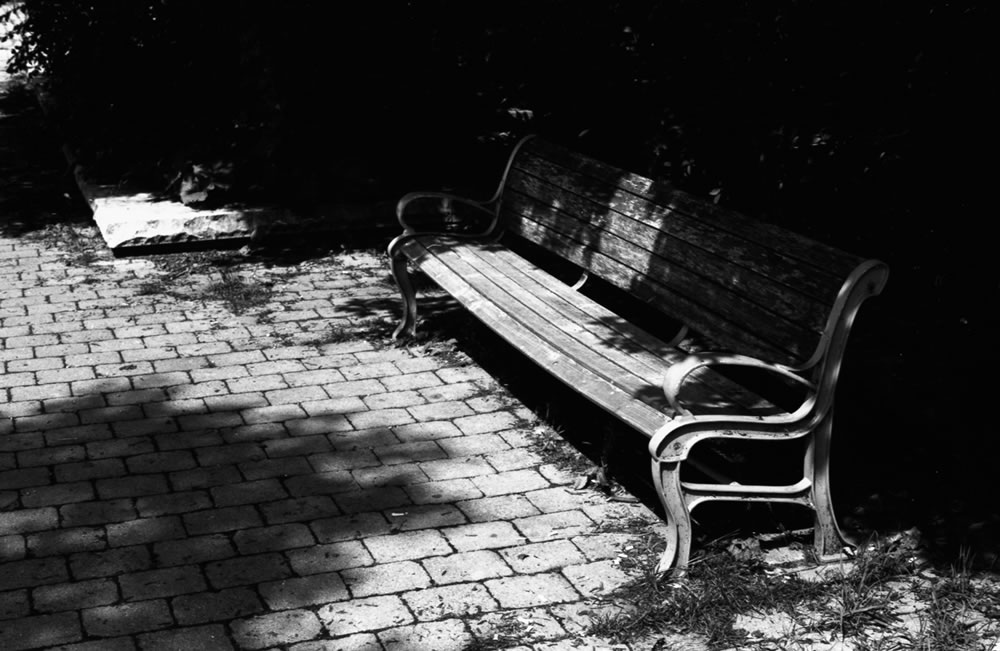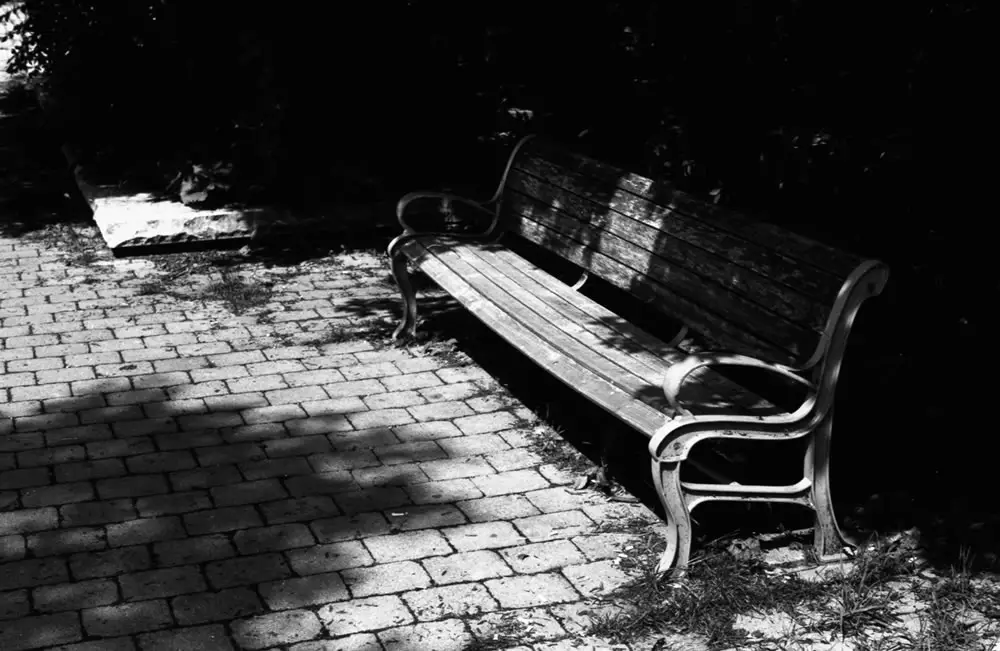With great anticipation, I unpacked my order of 5 precious rolls of FERRANIA P30 and ventured out to test this film. Fellini’s masterpiece, “8 1/2”, and FILM Ferrania’s revival story were my main motivators to jump into the fray. Visually, dream sequence scenes from “8 1/2” were the key driver to test this film out.
So, I went off to Sam Smith park with my Olympus OM-1 and a roll of FERRANIA P30 ALPHA to see how this would all work out. I particularly sought scenes with a decent shadow contrast, just to explore and see what kind of mood I can create. The day itself was an average July day, with some cloud but mostly sunny. The late afternoon delivered the light variety I wanted. I based my exposure on the Sunny 16 rule, aiming for the mid-tones. A handful of images from this, the second test roll, give a pretty good idea what is possible with P30.
Standard grain and tone test – clouds and mid-day scene. P30 delivers beautiful tones in a very sharp rendering. My favourites, however, are photos of the park bench and tree trunks covered in partial shade. Here, P30 ALPHA offers something truly unique. The right drop off of shadows into the total blackness, just to accentuate the subject through a subtle negative space.
I developed this roll in 1+1 dilution of ILFORD Perceptol powder developer. In a small Paterson tank with 300ml of solution, I agitated with the rotation rod for the initial 10 seconds and then for 10 seconds each minute. The total development time I used for P30 ALPHA was 20 minutes. To finish, I used Kodak Stop bath and Ilford Rapid Fixer in 1+4 dilution.





I am very pleased with the results of this combination. While “regular” exposure would likely demonstrate middle-of-the-road capability, where P30 really holds my interest is in the high contrast scenes. Like with so many other films, things get interesting at the extreme end of the exposure range.
Planning to head out again. I would definitely set my sights on shooting more dark negative space scenes, perhaps less aggressively exposed (more towards the shadows) and really working the “bench-type” scene in more detail. Once my order of Perceptol arrives, this may be the very thing to do with the remaining rolls from my Alpha order.
~ Toni Skokovic
Submit your 5 Frames… today
Get your own 5 Frames featured by submitting your article using this form or by sending an email via the contact link at the top of the page.
Share your knowledge, story or project
The transfer of knowledge across the film photography community is the heart of EMULSIVE. You can add your support by contributing your thoughts, work, experiences and ideas to inspire the hundreds of thousands of people who read these pages each month. Check out the submission guide here.
If you like what you’re reading you can also help this passion project by heading over to the EMULSIVE Patreon page and contributing as little as a dollar a month. There’s also print and apparel over at Society 6, currently showcasing over two dozen t-shirt designs and over a dozen unique photographs available for purchase.








14 responses to “5 Frames… With FERRANIA P30 ALPHA (EI 80 / 35mm / Olympus OM-1)”
Hello – it was an educated guess. I based my development time by approximating time by developers from Ferrania’s guide for similarly fast films, in my case – I looked at D-76 times for Delta 100 and Pan F 50 and how those compared to Perceptol 1+1 based on Ilford’s chart. Then made a guess of 20 minutes to get these results.
Additional comments I would like to make is that the time of 25-30 minutes in Perceptol 1+1 would probably give you more shadow detail, but these were also specifically exposed for mid tones and hi-lightes, a “habit” I get criticized and name-called often 🙂
Hope this helps
Question for you Toni – how did you come to the 20 minute dev time on Perceptol? Was this an educated guess or were you able to do some testing across rolls? I haven’t seen much on developing this film in Perceptol or a similar fine-grain developer. I want to try it just to see how it looks.
Coming to the party late here, but given the very little information out about it, I actually didn’t know that P30 should be rated under box speed. It actually says in the “Best Practices” guide that it works best rated at 80. I guess I should probably look into this more before I pop a roll in my camera.
U”h-huh. Ok. Two things:
1) Do you understand you’re not speaking to the author?
2) One does not offer advice, as you put it, by starting off with the words, “Here’s someone else who doesn’t know what he’s doing!”
Anyway, thanks for your suggestions. I’m sure Toni will consider it.”
1) Yes
2) Apologies for my bluntness.
Here’s someone else who doesn’t know what he’s doing! These pics are probably two stops under-exposed or more. Perceptol is a very fine grain developer that cuts the effective film speed in half. P30 seems to be a film with a real speed of 20-40 ISO. So by rating it at 80 ISO and developing it in Perceptol you have effectively under-exposed it by two-three stops.
You’re not seeing P30 offering anything “unique”: you’re just seeing what a film looks like when it’s been very under-exposed. Most films would look similar. If you don’t give enough exposure you get empty shadows. Get a roll of Tmax 100, rate it at 650 ISO and develop it in Perceptol and you’ll get all the “dark shadows” and “negative space” you want. For what that would be worth.
I would suggest you send over some tests of your own to share with the community. It would be great to see what you come up with, especially given the amount of advice you’re offering here.
The “amount of advice” I’m offering is, believe it or not, common knowledge amongst experienced film photographers and nothing unique to me. The fact that it strikes you as such is an indication that you really don’t know that much and should probably do more reading and research before writing anything further. Just now, you’re like a motoring journalist driving around in first gear and complaining about the car’s poor maximum speed.
Uh-huh. Ok. Two things:
1) Do you understand you’re not speaking to the author?
2) One does not offer advice, as you put it, by starting off with the words, “Here’s someone else who doesn’t know what he’s doing!”
Anyway, thanks for your suggestions. I’m sure Toni will consider it.
Hello Bruce – thank you, appreciate the feedback. It is very interesting and motivating despite all the vitriol of judgement. Best, Toni
Well, Bruce was a little harsh, but entirely correct.
P30 is already a fairly slow fine grain film, and won’t benefit much from development in Perceptol, which trades finer grain for a loss of roughly 1 stop of speed.
Look here: https://static1.squarespace.com/static/51ec6e85e4b01f370623e09d/t/5984c3cc414fb5bec62ca76f/1501873101104/P30_Best_Practices_v1-5.pdf
for Ferrania’s developer/time suggestions. They include D-76 and Xtol, which are inexpensive and easy to find.
He’s correct about exposure, too. If you’re using “sunny sixteen,” I guess you don’t have a meter? If you did, you’d meter the darkest shadow you want some detail in, and then close down two, or maybe three stops. The shadows will go dark, but not empty black. Without a meter, open up 2 or three from your sunny sixteen setting. It’s a balancing act between getting shadow detail and blocking up the highlights. Experiment with bracketing your exposures and see what happens. Try your sunny sixteen exposure, then one stop more, then 2 stops more, if there are deep shadows in the frame. P30 seems already a little slower than the box speed, so a little more exposure can’t hurt. Worst case, you’ll learn something about how the image changes with exposure.
It’s true that if you do a sunny sixteen exposure with any film, you’ll get inky blackness in the shadows. The more so with your film/developer combination.
Hope that was helpful.
Hello Scott – just saw notification pop up for this comment – sorry for the delay in responding. This discussion is really about what is the right exposure and how best to develop P30. With most black&white film, I deliberately expose for mid-tones of hi-lights since I love the “crushed shadows” look. I realize now that I did not necessarily mention that in my write up on this film. Typically, I would find the “hot spot” hi-light in my scene and then back it up a stop or two. In that process, I always have an underexposed part to the image, and that looks great when printed in darkroom (on inkjet printer, not so much). It’s the look I like, something I discovered with digital cameras and realized how much more you can get with the same, I admit unorthodox, approach with film.
Hope this makes sense and clarifies the things somewhat. I am never endeavouring to do a comprehensive test of a film or a method, but just share my process, specific to the aesthetic I am chasing.
Nice shots, park bench and clouds are my favourite, but all are very good, I need to give P30 a try sometime !
Thanks Stig! Yes – I can’t wait for them to re-open the store. Great story and good film to shoot with.
https://emulsive.org/articles/5-frames-with/5-frames-15-ferrania-p30-alpha-ei-80-35mm-perceptol-toni-skokovic